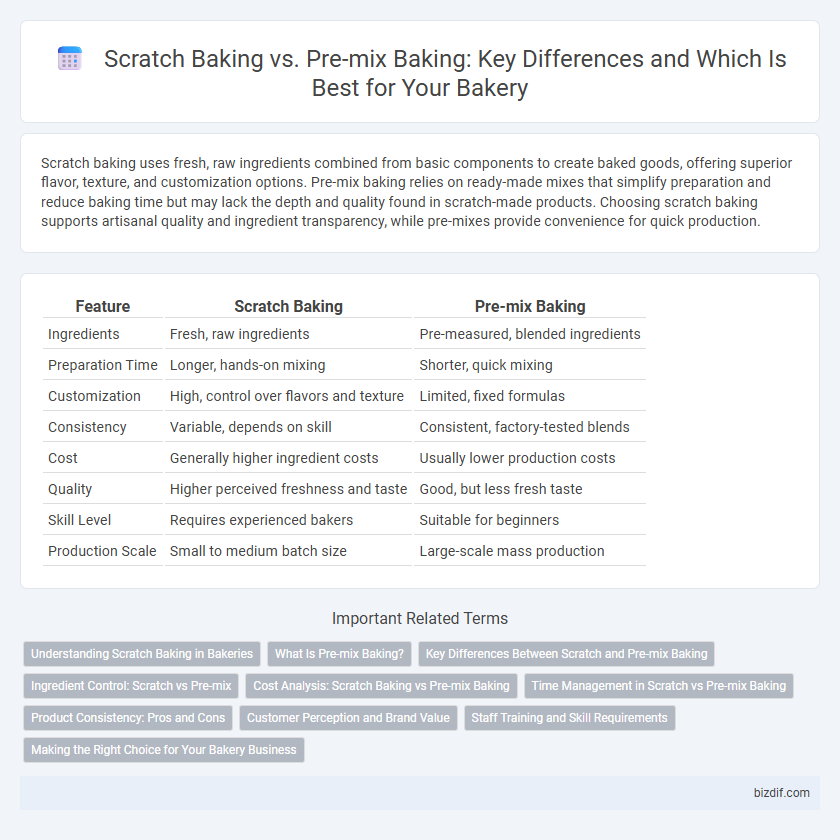Scratch baking uses fresh, raw ingredients combined from basic components to create baked goods, offering superior flavor, texture, and customization options. Pre-mix baking relies on ready-made mixes that simplify preparation and reduce baking time but may lack the depth and quality found in scratch-made products. Choosing scratch baking supports artisanal quality and ingredient transparency, while pre-mixes provide convenience for quick production.
Table of Comparison
| Feature | Scratch Baking | Pre-mix Baking |
|---|---|---|
| Ingredients | Fresh, raw ingredients | Pre-measured, blended ingredients |
| Preparation Time | Longer, hands-on mixing | Shorter, quick mixing |
| Customization | High, control over flavors and texture | Limited, fixed formulas |
| Consistency | Variable, depends on skill | Consistent, factory-tested blends |
| Cost | Generally higher ingredient costs | Usually lower production costs |
| Quality | Higher perceived freshness and taste | Good, but less fresh taste |
| Skill Level | Requires experienced bakers | Suitable for beginners |
| Production Scale | Small to medium batch size | Large-scale mass production |
Understanding Scratch Baking in Bakeries
Scratch baking in bakeries involves using raw ingredients such as flour, sugar, yeast, and eggs, allowing bakers to control quality and customize recipes for unique flavors and textures. This method enhances freshness and product authenticity compared to pre-mix baking, where ingredients are pre-blended, limiting ingredient control. Mastery of scratch baking techniques is essential for artisanal bakeries aiming to deliver superior taste and handmade craftsmanship.
What Is Pre-mix Baking?
Pre-mix baking involves using pre-measured ingredients combined in a single package to streamline the baking process and ensure consistent results. These mixes often include flour, leavening agents, sugar, and sometimes flavorings or dehydrated eggs, allowing bakers to save time and reduce preparation errors. Pre-mix baking is especially popular in commercial bakeries where efficiency and uniformity are critical to meeting high-volume production demands.
Key Differences Between Scratch and Pre-mix Baking
Scratch baking involves creating baked goods from basic ingredients like flour, sugar, eggs, and butter, allowing full control over texture, flavor, and ingredient quality. Pre-mix baking relies on commercially prepared mixes that combine ingredients in fixed proportions, offering convenience and consistent results but limited customization. Key differences lie in ingredient transparency, preparation time, and the ability to tailor recipes to specific dietary needs or flavor preferences.
Ingredient Control: Scratch vs Pre-mix
Scratch baking offers complete ingredient control, allowing bakers to customize recipes for freshness, flavor, and dietary needs by selecting high-quality, natural components. Pre-mix baking relies on pre-measured blends that limit ingredient customization and often include preservatives or additives. Ingredient control in scratch baking enhances product quality, nutritional value, and allows for tailoring to specific allergen or taste preferences.
Cost Analysis: Scratch Baking vs Pre-mix Baking
Scratch baking often incurs higher upfront costs due to purchasing raw ingredients in bulk and investing time in preparation, but it can lead to better control over quality and ingredient sourcing. Pre-mix baking reduces labor and time expenses by using ready-made mixes, which can lower operational costs for smaller bakeries or high-volume production. Overall, scratch baking may have higher variable costs but offers potential savings on ingredient flexibility, while pre-mix baking provides cost predictability and efficiency for consistent product output.
Time Management in Scratch vs Pre-mix Baking
Scratch baking demands more time for ingredient preparation and mixing, which can extend production schedules and require careful labor allocation. Pre-mix baking significantly reduces preparation time by using ready-made blends, allowing bakers to increase output and meet tight deadlines efficiently. Time management in scratch baking hinges on balancing quality with labor-intensive processes, while pre-mix baking prioritizes speed and consistency.
Product Consistency: Pros and Cons
Scratch baking offers unparalleled control over ingredient quality and freshness, resulting in a product with unique texture and flavor profiles that can be customized per batch. However, it may suffer from inconsistency due to variations in ingredient measurements and human error. Pre-mix baking ensures consistent product quality and uniformity across multiple batches through standardized formulations but may lack the distinctive taste and texture that scratch baking provides.
Customer Perception and Brand Value
Scratch baking is often perceived by customers as a mark of quality and authenticity, enhancing the bakery's brand value through the use of fresh, natural ingredients. Pre-mix baking appeals to convenience and consistency, but may risk being viewed as less artisanal or homemade, potentially diminishing the perceived craftsmanship. Brands emphasizing scratch baking tend to build stronger emotional connections and customer loyalty due to the association with traditional craftsmanship and superior taste.
Staff Training and Skill Requirements
Scratch baking demands extensive staff training to master precise measurements, ingredient handling, and recipe formulation, fostering creativity and consistency. Pre-mix baking simplifies processes, requiring less specialized skills and shorter training times, enabling quicker onboarding of new employees. Investing in scratch baking staff development enhances product quality and allows for customization, while pre-mix baking prioritizes efficiency and uniformity with minimal skill variation.
Making the Right Choice for Your Bakery Business
Choosing between scratch baking and pre-mix baking depends on your bakery's goals, target customers, and operational capacity. Scratch baking offers superior flavor customization and product uniqueness, appealing to artisanal and premium markets, but requires skilled labor and longer preparation times. Pre-mix baking enhances consistency, speed, and cost-efficiency, making it ideal for high-volume and standardized product lines, yet it limits recipe flexibility and can impact perceived quality.
Scratch Baking vs Pre-mix Baking Infographic

 bizdif.com
bizdif.com